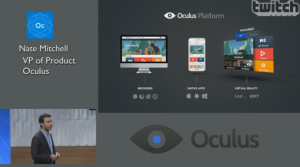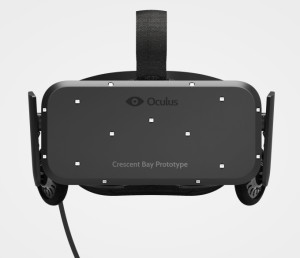Oculus Reveals Its New “Crescent Bay” Prototype With 360-Degree Head Tracking And Headphones

 During the 10 minute demo, I hung out with a tyrannosaurus rex, perched on top of a skyscraper, stood by a fire with some woodland creatures in a polygonal field, floated over a SimCity, shrunk down to microscopic size to look at giant dust mite, and watched a SWAT team fight a giant battle mech.
During the 10 minute demo, I hung out with a tyrannosaurus rex, perched on top of a skyscraper, stood by a fire with some woodland creatures in a polygonal field, floated over a SimCity, shrunk down to microscopic size to look at giant dust mite, and watched a SWAT team fight a giant battle mech.
The headset is remarkably light, causing no neck strain. The goggle portion feels like mid-quality hollow plastic, though overall it feels pretty durable for its weight. The field of vision is significantly wider than the Samsung Gear VR, which is a bit like looking through binoculars because you can see the frame around the screen. ...
The best part was how quick and accurate the motion tracking was. At one point in the demo, I was in a dressing room in front of a mirror with a floating mask mimicing my movements. No matter how fast I turned or spun around, I couldn’t detect any real latency in the mask. The motion tracking always kept up.
...The way it does the motion tracking is with an array of tiny LEDs layered over the outside of the Crescent Bay headset. Unlike the DK2 which just used LEDs on the front, there’s a back panel to the strap that goes around you head which holds LEDs that can also be tracked with a camera so Oculus knows when you turn all the way around.
Oculus CEO Brendan Iribe announced that over 100,000 Rift developer kits have shipped to over 130 countries. He said “If you love sci-fi, this is your holy grail....
To do that, Oculus needed to nail “Presence” or feeling like you’re actually in the virtual world. That means nailing every component of a VR rig so that no step causes motion sickness. These components are tracking the motion of your head, CPU, GPU, display, photons, optics.
Iribe went on to explain that Oculus sees VR as dividing into two categories, and that it needs to win at both:
- PC-based: Where computers can drive the most immersive experiences.
“With positional tracking, high frame rates, low persistence, and strong GPUs, you can create unbelievable worlds, you can create believable worlds.”
- Mobile-based: Where affordability, accessibility, and mobility will bring VR to a mass audience.
See the full story here: http://techcrunch.com/2014/09/20/oculus-connect-announcements/?ncid=tcdaily
Pages
- About Philip Lelyveld
- Mark and Addie Lelyveld Biographies
- Presentations and articles
- Tufts Alumni Bio